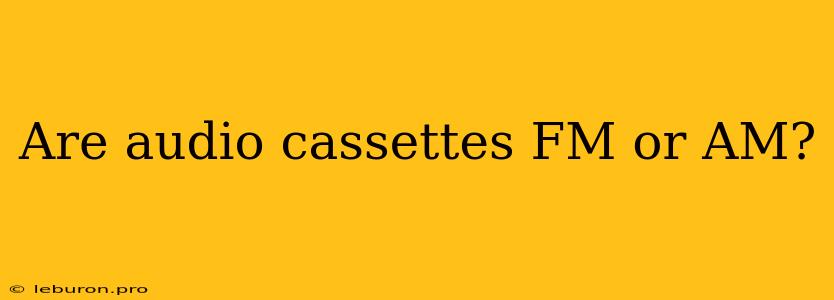Audio cassettes, a popular format for music and audio recordings in the past, utilize neither FM nor AM technology. Instead, they rely on a different method of recording and playback: magnetic recording. This means that audio signals are converted into magnetic variations on a thin strip of magnetic tape housed within the cassette. Unlike radio waves, which travel through the air, audio cassettes store information physically on the tape, making them a tangible and durable storage medium.
Understanding FM and AM
To understand why audio cassettes are not FM or AM, it's crucial to grasp the concepts of frequency modulation (FM) and amplitude modulation (AM), the two primary methods of radio broadcasting.
FM Radio
FM radio uses frequency modulation to transmit audio signals. In FM, the frequency of the radio wave is varied in accordance with the audio signal, while the amplitude (strength) remains constant. This method provides higher fidelity and less static than AM radio.
AM Radio
AM radio, on the other hand, uses amplitude modulation to transmit audio signals. Here, the amplitude (strength) of the radio wave is varied in accordance with the audio signal, while the frequency remains constant. While AM radio has a longer range than FM, it is susceptible to static and interference, resulting in lower fidelity.
How Audio Cassettes Work
Unlike radio waves, which are electromagnetic waves that travel through the air, audio cassettes use a physical medium, magnetic tape, to store audio information. Here's how it works:
- Recording: During recording, an audio signal is converted into an electrical signal. This electrical signal then controls the strength of an electromagnet, which magnetizes tiny iron oxide particles on the tape. Different patterns of magnetization on the tape correspond to different audio frequencies.
- Playback: During playback, the tape passes over a playback head, a coil of wire. The magnetized particles on the tape create a fluctuating magnetic field that induces an electrical current in the playback head. This electrical signal is then amplified and converted back into an audio signal, allowing us to hear the recorded sound.
Key Differences Between Audio Cassettes and Radio
Here are the key differences between audio cassettes and radio:
| Feature | Audio Cassette | Radio |
|---|---|---|
| Transmission Method | Magnetic recording | Electromagnetic waves (FM or AM) |
| Storage Medium | Magnetic tape | Air |
| Physical vs. Wireless | Physical | Wireless |
| Fidelity | Typically lower fidelity than FM radio | FM: High fidelity; AM: Lower fidelity |
| Durability | Durable but susceptible to wear and tear | Subject to interference and atmospheric conditions |
Conclusion
Audio cassettes, while a beloved format in the past, operate differently from FM or AM radio. They utilize magnetic recording to store audio signals on a physical medium, unlike radio waves which transmit audio wirelessly through the air. While radio offers advantages like wireless transmission and high fidelity (especially in FM), audio cassettes provide a tangible and durable form of audio storage. Their unique recording and playback mechanism, involving magnetic tape, sets them apart from the radio waves used in FM and AM broadcasting.
